Aldi Australia: Innovation in a Competitive Market Report
VerifiedAdded on 2021/05/27
|12
|2929
|69
Report
AI Summary
This report provides a comprehensive analysis of Aldi Australia's business model, focusing on the challenges posed by changing consumer behaviors and the potential entry of competitors like Amazon. The study identifies the 'Bricks and Mortar' format as potentially outdated, particularly for younger consumers who prefer online shopping. To address these issues, the report proposes the implementation of a 'Bricks and Clicks' business model, which integrates physical stores with an online presence, offering customers the flexibility of both in-store and online shopping experiences, including home delivery and in-store pickup options. The report highlights the benefits for both customers and the business, including increased convenience, enhanced customer retention, and cost-effectiveness. It also evaluates the feasibility of the proposed model, considering factors such as production costs, ease of implementation, and marketing strategies, concluding that the 'Bricks and Clicks' model is a viable and beneficial strategy for Aldi Australia to maintain its competitive edge and attract future customers. The report also includes a reflection on group collaboration and contributions to the project.
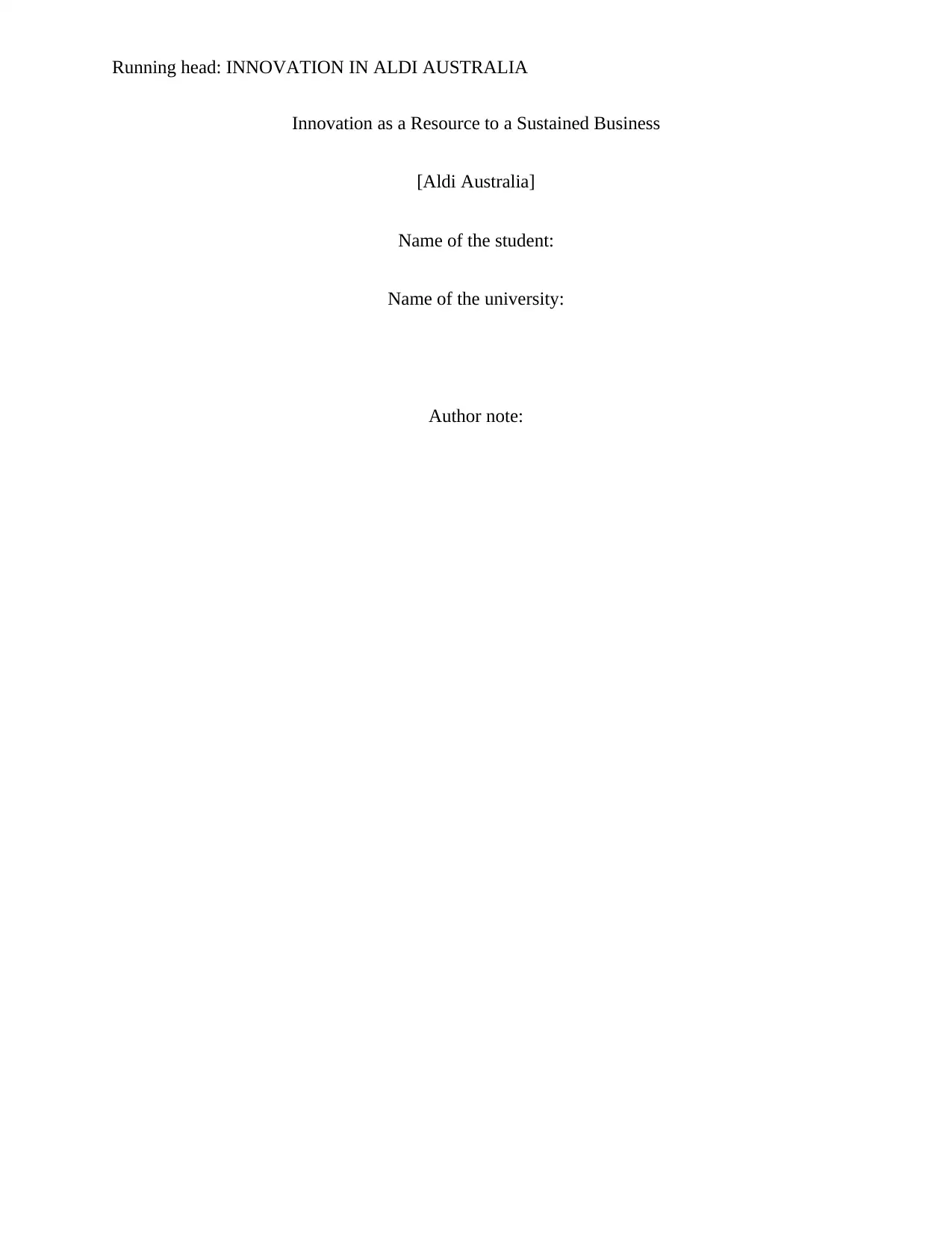
Running head: INNOVATION IN ALDI AUSTRALIA
Innovation as a Resource to a Sustained Business
[Aldi Australia]
Name of the student:
Name of the university:
Author note:
Innovation as a Resource to a Sustained Business
[Aldi Australia]
Name of the student:
Name of the university:
Author note:
Paraphrase This Document
Need a fresh take? Get an instant paraphrase of this document with our AI Paraphraser
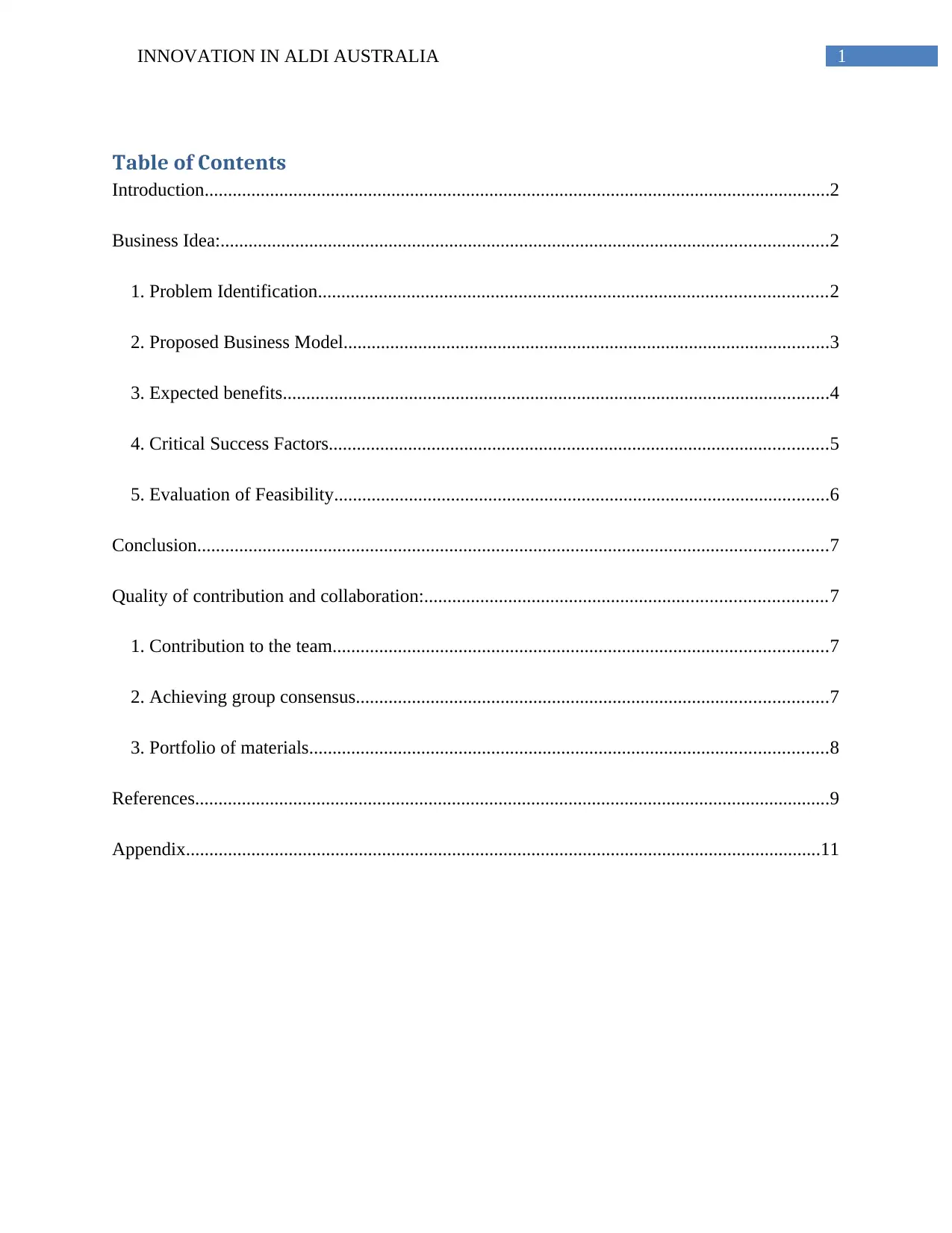
1INNOVATION IN ALDI AUSTRALIA
Table of Contents
Introduction......................................................................................................................................2
Business Idea:..................................................................................................................................2
1. Problem Identification.............................................................................................................2
2. Proposed Business Model........................................................................................................3
3. Expected benefits.....................................................................................................................4
4. Critical Success Factors...........................................................................................................5
5. Evaluation of Feasibility..........................................................................................................6
Conclusion.......................................................................................................................................7
Quality of contribution and collaboration:......................................................................................7
1. Contribution to the team..........................................................................................................7
2. Achieving group consensus.....................................................................................................7
3. Portfolio of materials...............................................................................................................8
References........................................................................................................................................9
Appendix........................................................................................................................................11
Table of Contents
Introduction......................................................................................................................................2
Business Idea:..................................................................................................................................2
1. Problem Identification.............................................................................................................2
2. Proposed Business Model........................................................................................................3
3. Expected benefits.....................................................................................................................4
4. Critical Success Factors...........................................................................................................5
5. Evaluation of Feasibility..........................................................................................................6
Conclusion.......................................................................................................................................7
Quality of contribution and collaboration:......................................................................................7
1. Contribution to the team..........................................................................................................7
2. Achieving group consensus.....................................................................................................7
3. Portfolio of materials...............................................................................................................8
References........................................................................................................................................9
Appendix........................................................................................................................................11
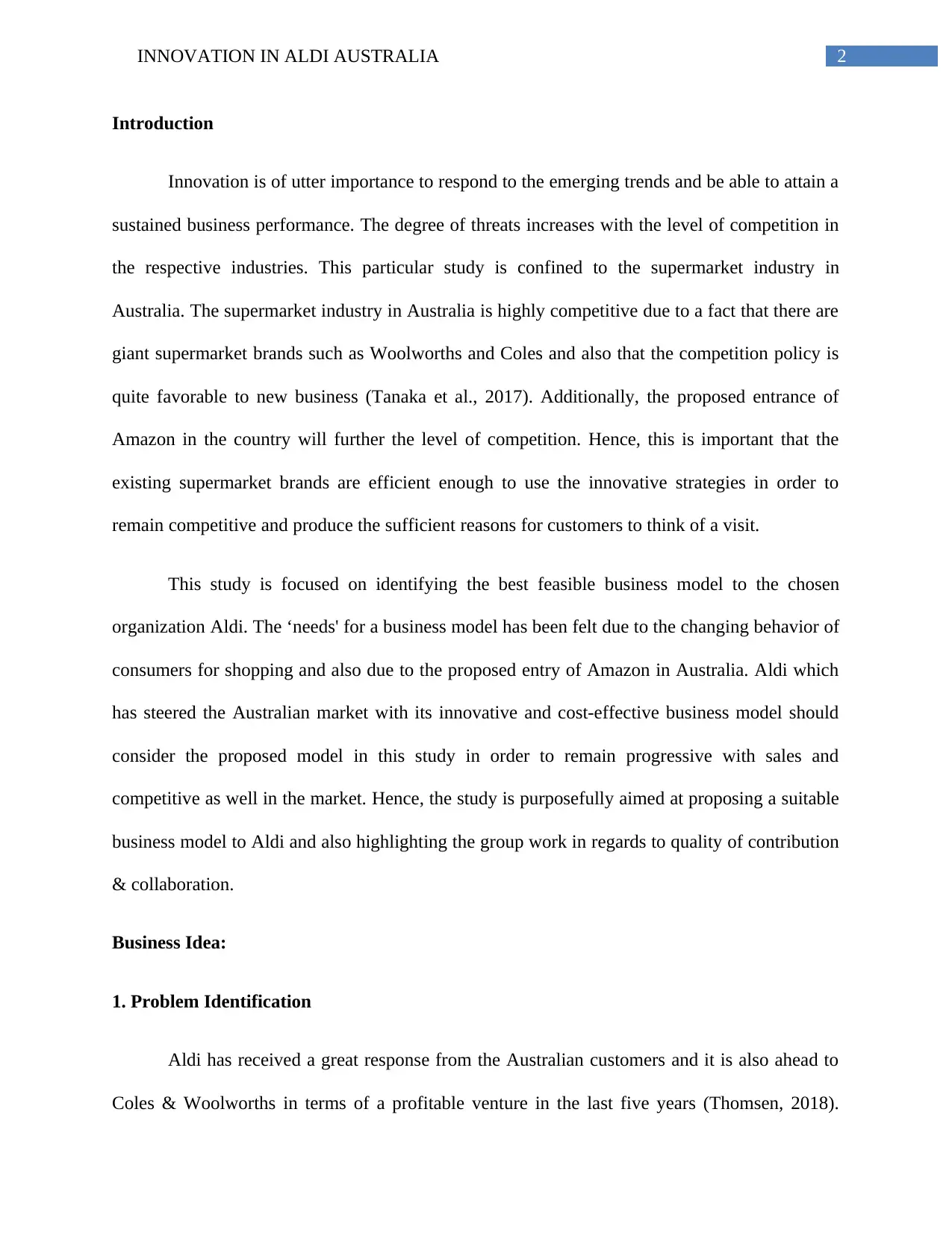
2INNOVATION IN ALDI AUSTRALIA
Introduction
Innovation is of utter importance to respond to the emerging trends and be able to attain a
sustained business performance. The degree of threats increases with the level of competition in
the respective industries. This particular study is confined to the supermarket industry in
Australia. The supermarket industry in Australia is highly competitive due to a fact that there are
giant supermarket brands such as Woolworths and Coles and also that the competition policy is
quite favorable to new business (Tanaka et al., 2017). Additionally, the proposed entrance of
Amazon in the country will further the level of competition. Hence, this is important that the
existing supermarket brands are efficient enough to use the innovative strategies in order to
remain competitive and produce the sufficient reasons for customers to think of a visit.
This study is focused on identifying the best feasible business model to the chosen
organization Aldi. The ‘needs' for a business model has been felt due to the changing behavior of
consumers for shopping and also due to the proposed entry of Amazon in Australia. Aldi which
has steered the Australian market with its innovative and cost-effective business model should
consider the proposed model in this study in order to remain progressive with sales and
competitive as well in the market. Hence, the study is purposefully aimed at proposing a suitable
business model to Aldi and also highlighting the group work in regards to quality of contribution
& collaboration.
Business Idea:
1. Problem Identification
Aldi has received a great response from the Australian customers and it is also ahead to
Coles & Woolworths in terms of a profitable venture in the last five years (Thomsen, 2018).
Introduction
Innovation is of utter importance to respond to the emerging trends and be able to attain a
sustained business performance. The degree of threats increases with the level of competition in
the respective industries. This particular study is confined to the supermarket industry in
Australia. The supermarket industry in Australia is highly competitive due to a fact that there are
giant supermarket brands such as Woolworths and Coles and also that the competition policy is
quite favorable to new business (Tanaka et al., 2017). Additionally, the proposed entrance of
Amazon in the country will further the level of competition. Hence, this is important that the
existing supermarket brands are efficient enough to use the innovative strategies in order to
remain competitive and produce the sufficient reasons for customers to think of a visit.
This study is focused on identifying the best feasible business model to the chosen
organization Aldi. The ‘needs' for a business model has been felt due to the changing behavior of
consumers for shopping and also due to the proposed entry of Amazon in Australia. Aldi which
has steered the Australian market with its innovative and cost-effective business model should
consider the proposed model in this study in order to remain progressive with sales and
competitive as well in the market. Hence, the study is purposefully aimed at proposing a suitable
business model to Aldi and also highlighting the group work in regards to quality of contribution
& collaboration.
Business Idea:
1. Problem Identification
Aldi has received a great response from the Australian customers and it is also ahead to
Coles & Woolworths in terms of a profitable venture in the last five years (Thomsen, 2018).
⊘ This is a preview!⊘
Do you want full access?
Subscribe today to unlock all pages.

Trusted by 1+ million students worldwide
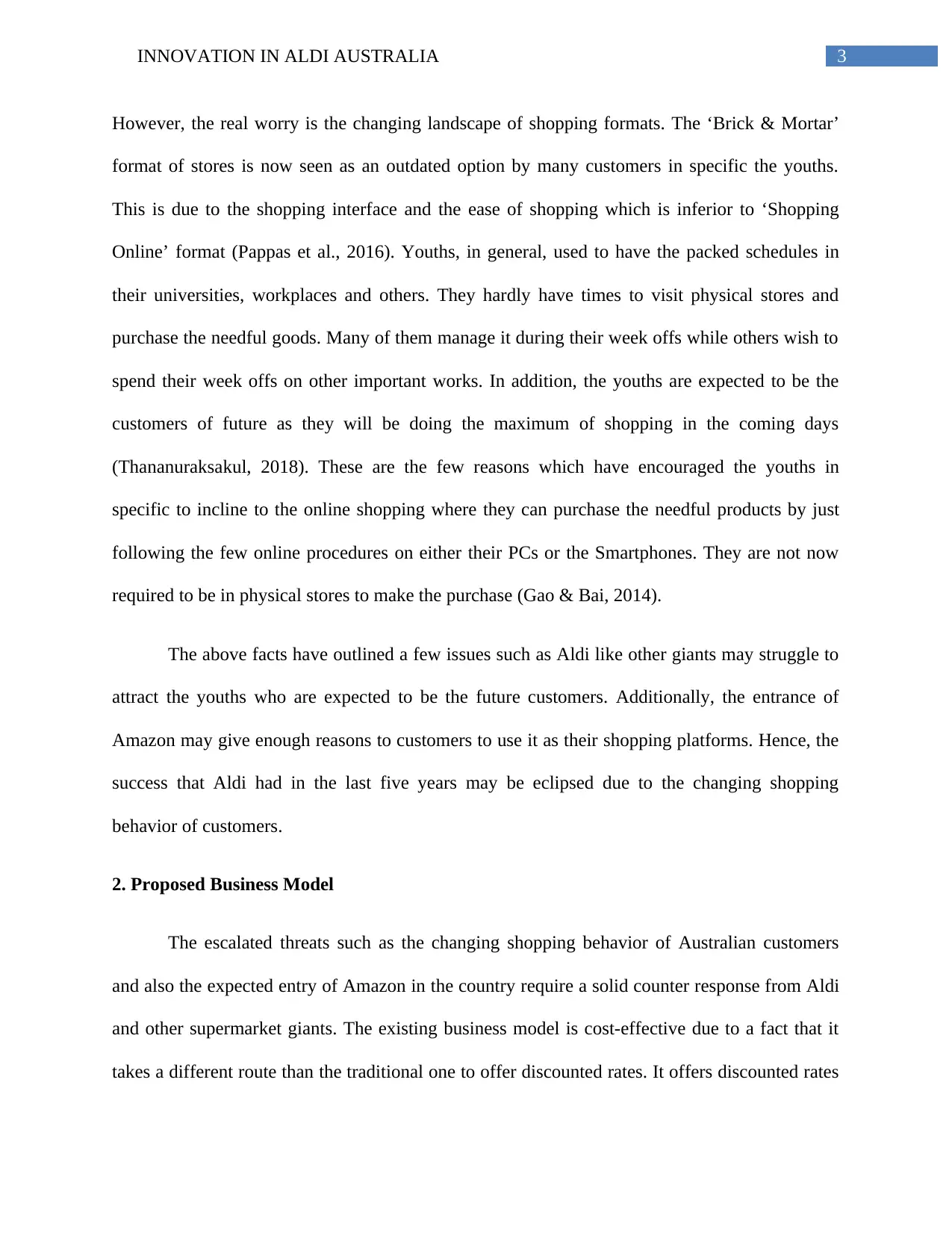
3INNOVATION IN ALDI AUSTRALIA
However, the real worry is the changing landscape of shopping formats. The ‘Brick & Mortar’
format of stores is now seen as an outdated option by many customers in specific the youths.
This is due to the shopping interface and the ease of shopping which is inferior to ‘Shopping
Online’ format (Pappas et al., 2016). Youths, in general, used to have the packed schedules in
their universities, workplaces and others. They hardly have times to visit physical stores and
purchase the needful goods. Many of them manage it during their week offs while others wish to
spend their week offs on other important works. In addition, the youths are expected to be the
customers of future as they will be doing the maximum of shopping in the coming days
(Thananuraksakul, 2018). These are the few reasons which have encouraged the youths in
specific to incline to the online shopping where they can purchase the needful products by just
following the few online procedures on either their PCs or the Smartphones. They are not now
required to be in physical stores to make the purchase (Gao & Bai, 2014).
The above facts have outlined a few issues such as Aldi like other giants may struggle to
attract the youths who are expected to be the future customers. Additionally, the entrance of
Amazon may give enough reasons to customers to use it as their shopping platforms. Hence, the
success that Aldi had in the last five years may be eclipsed due to the changing shopping
behavior of customers.
2. Proposed Business Model
The escalated threats such as the changing shopping behavior of Australian customers
and also the expected entry of Amazon in the country require a solid counter response from Aldi
and other supermarket giants. The existing business model is cost-effective due to a fact that it
takes a different route than the traditional one to offer discounted rates. It offers discounted rates
However, the real worry is the changing landscape of shopping formats. The ‘Brick & Mortar’
format of stores is now seen as an outdated option by many customers in specific the youths.
This is due to the shopping interface and the ease of shopping which is inferior to ‘Shopping
Online’ format (Pappas et al., 2016). Youths, in general, used to have the packed schedules in
their universities, workplaces and others. They hardly have times to visit physical stores and
purchase the needful goods. Many of them manage it during their week offs while others wish to
spend their week offs on other important works. In addition, the youths are expected to be the
customers of future as they will be doing the maximum of shopping in the coming days
(Thananuraksakul, 2018). These are the few reasons which have encouraged the youths in
specific to incline to the online shopping where they can purchase the needful products by just
following the few online procedures on either their PCs or the Smartphones. They are not now
required to be in physical stores to make the purchase (Gao & Bai, 2014).
The above facts have outlined a few issues such as Aldi like other giants may struggle to
attract the youths who are expected to be the future customers. Additionally, the entrance of
Amazon may give enough reasons to customers to use it as their shopping platforms. Hence, the
success that Aldi had in the last five years may be eclipsed due to the changing shopping
behavior of customers.
2. Proposed Business Model
The escalated threats such as the changing shopping behavior of Australian customers
and also the expected entry of Amazon in the country require a solid counter response from Aldi
and other supermarket giants. The existing business model is cost-effective due to a fact that it
takes a different route than the traditional one to offer discounted rates. It offers discounted rates
Paraphrase This Document
Need a fresh take? Get an instant paraphrase of this document with our AI Paraphraser
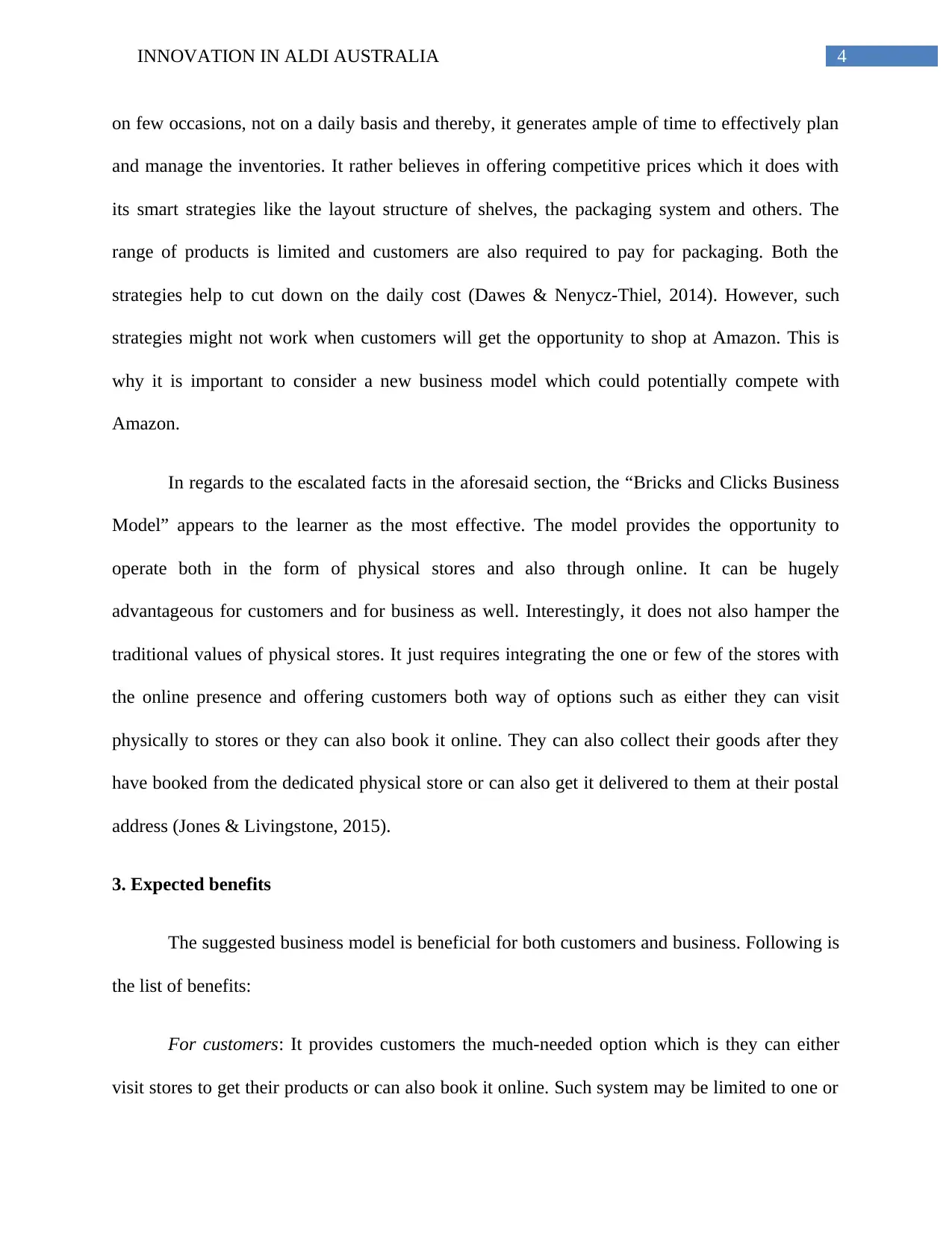
4INNOVATION IN ALDI AUSTRALIA
on few occasions, not on a daily basis and thereby, it generates ample of time to effectively plan
and manage the inventories. It rather believes in offering competitive prices which it does with
its smart strategies like the layout structure of shelves, the packaging system and others. The
range of products is limited and customers are also required to pay for packaging. Both the
strategies help to cut down on the daily cost (Dawes & Nenycz-Thiel, 2014). However, such
strategies might not work when customers will get the opportunity to shop at Amazon. This is
why it is important to consider a new business model which could potentially compete with
Amazon.
In regards to the escalated facts in the aforesaid section, the “Bricks and Clicks Business
Model” appears to the learner as the most effective. The model provides the opportunity to
operate both in the form of physical stores and also through online. It can be hugely
advantageous for customers and for business as well. Interestingly, it does not also hamper the
traditional values of physical stores. It just requires integrating the one or few of the stores with
the online presence and offering customers both way of options such as either they can visit
physically to stores or they can also book it online. They can also collect their goods after they
have booked from the dedicated physical store or can also get it delivered to them at their postal
address (Jones & Livingstone, 2015).
3. Expected benefits
The suggested business model is beneficial for both customers and business. Following is
the list of benefits:
For customers: It provides customers the much-needed option which is they can either
visit stores to get their products or can also book it online. Such system may be limited to one or
on few occasions, not on a daily basis and thereby, it generates ample of time to effectively plan
and manage the inventories. It rather believes in offering competitive prices which it does with
its smart strategies like the layout structure of shelves, the packaging system and others. The
range of products is limited and customers are also required to pay for packaging. Both the
strategies help to cut down on the daily cost (Dawes & Nenycz-Thiel, 2014). However, such
strategies might not work when customers will get the opportunity to shop at Amazon. This is
why it is important to consider a new business model which could potentially compete with
Amazon.
In regards to the escalated facts in the aforesaid section, the “Bricks and Clicks Business
Model” appears to the learner as the most effective. The model provides the opportunity to
operate both in the form of physical stores and also through online. It can be hugely
advantageous for customers and for business as well. Interestingly, it does not also hamper the
traditional values of physical stores. It just requires integrating the one or few of the stores with
the online presence and offering customers both way of options such as either they can visit
physically to stores or they can also book it online. They can also collect their goods after they
have booked from the dedicated physical store or can also get it delivered to them at their postal
address (Jones & Livingstone, 2015).
3. Expected benefits
The suggested business model is beneficial for both customers and business. Following is
the list of benefits:
For customers: It provides customers the much-needed option which is they can either
visit stores to get their products or can also book it online. Such system may be limited to one or
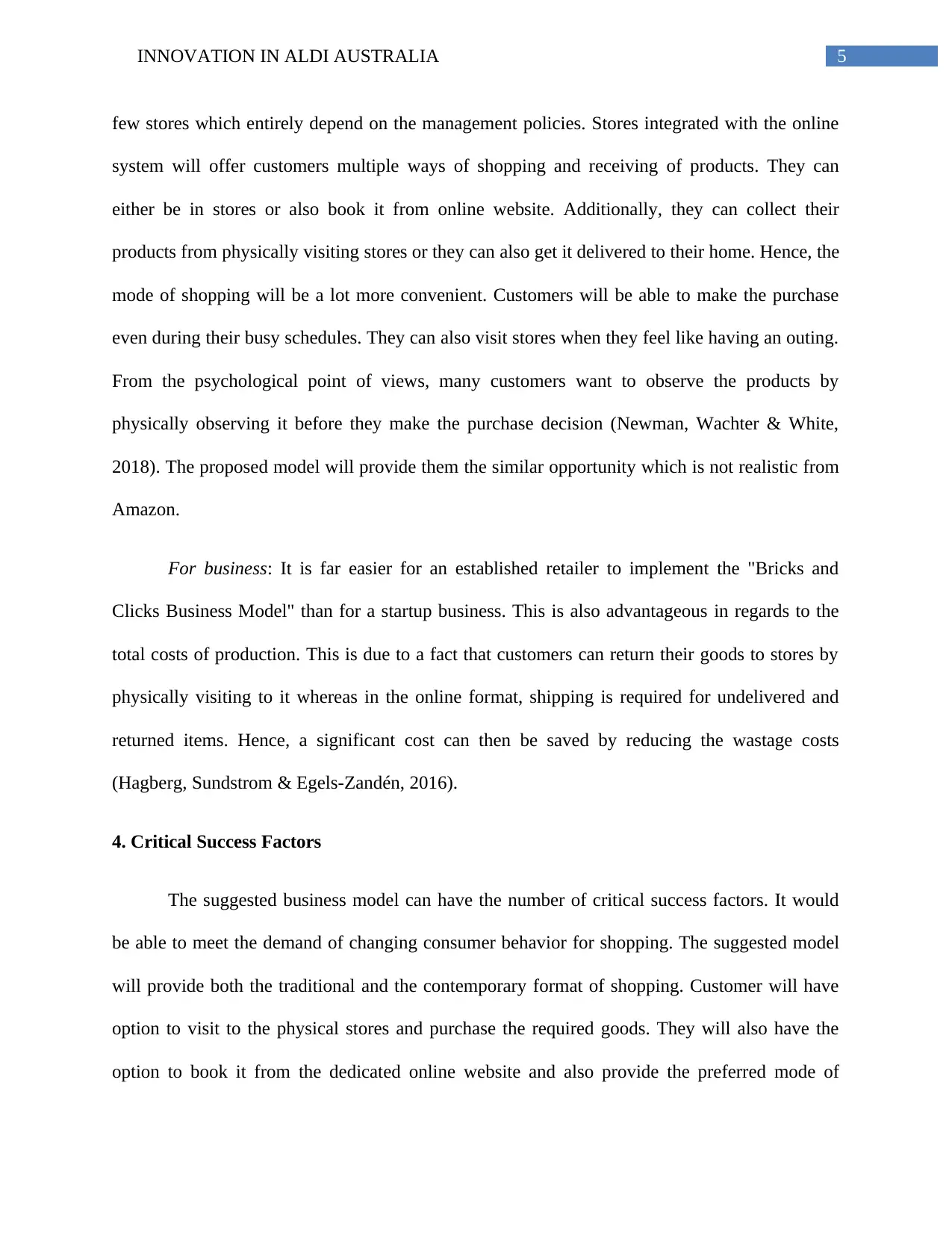
5INNOVATION IN ALDI AUSTRALIA
few stores which entirely depend on the management policies. Stores integrated with the online
system will offer customers multiple ways of shopping and receiving of products. They can
either be in stores or also book it from online website. Additionally, they can collect their
products from physically visiting stores or they can also get it delivered to their home. Hence, the
mode of shopping will be a lot more convenient. Customers will be able to make the purchase
even during their busy schedules. They can also visit stores when they feel like having an outing.
From the psychological point of views, many customers want to observe the products by
physically observing it before they make the purchase decision (Newman, Wachter & White,
2018). The proposed model will provide them the similar opportunity which is not realistic from
Amazon.
For business: It is far easier for an established retailer to implement the "Bricks and
Clicks Business Model" than for a startup business. This is also advantageous in regards to the
total costs of production. This is due to a fact that customers can return their goods to stores by
physically visiting to it whereas in the online format, shipping is required for undelivered and
returned items. Hence, a significant cost can then be saved by reducing the wastage costs
(Hagberg, Sundstrom & Egels-Zandén, 2016).
4. Critical Success Factors
The suggested business model can have the number of critical success factors. It would
be able to meet the demand of changing consumer behavior for shopping. The suggested model
will provide both the traditional and the contemporary format of shopping. Customer will have
option to visit to the physical stores and purchase the required goods. They will also have the
option to book it from the dedicated online website and also provide the preferred mode of
few stores which entirely depend on the management policies. Stores integrated with the online
system will offer customers multiple ways of shopping and receiving of products. They can
either be in stores or also book it from online website. Additionally, they can collect their
products from physically visiting stores or they can also get it delivered to their home. Hence, the
mode of shopping will be a lot more convenient. Customers will be able to make the purchase
even during their busy schedules. They can also visit stores when they feel like having an outing.
From the psychological point of views, many customers want to observe the products by
physically observing it before they make the purchase decision (Newman, Wachter & White,
2018). The proposed model will provide them the similar opportunity which is not realistic from
Amazon.
For business: It is far easier for an established retailer to implement the "Bricks and
Clicks Business Model" than for a startup business. This is also advantageous in regards to the
total costs of production. This is due to a fact that customers can return their goods to stores by
physically visiting to it whereas in the online format, shipping is required for undelivered and
returned items. Hence, a significant cost can then be saved by reducing the wastage costs
(Hagberg, Sundstrom & Egels-Zandén, 2016).
4. Critical Success Factors
The suggested business model can have the number of critical success factors. It would
be able to meet the demand of changing consumer behavior for shopping. The suggested model
will provide both the traditional and the contemporary format of shopping. Customer will have
option to visit to the physical stores and purchase the required goods. They will also have the
option to book it from the dedicated online website and also provide the preferred mode of
⊘ This is a preview!⊘
Do you want full access?
Subscribe today to unlock all pages.

Trusted by 1+ million students worldwide
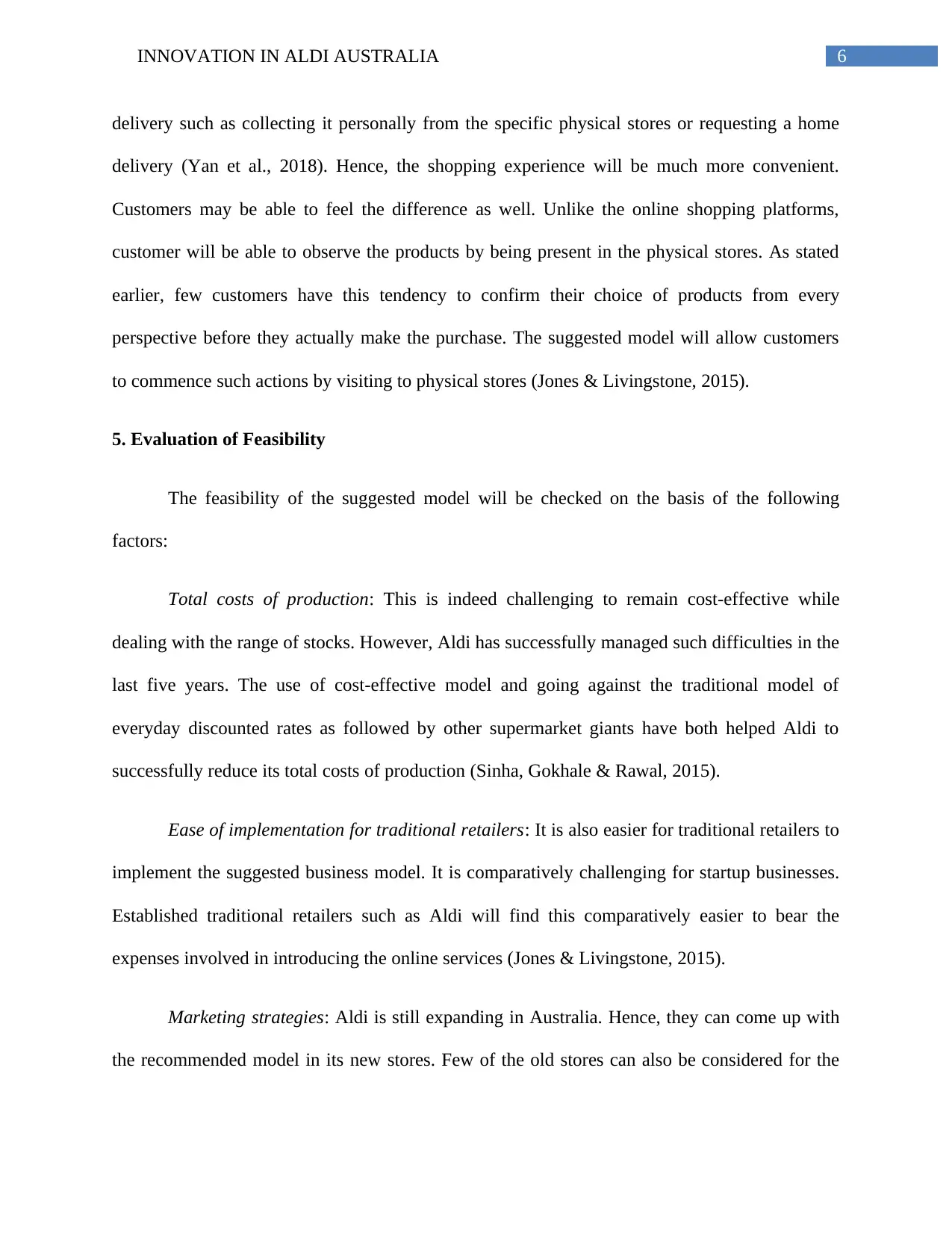
6INNOVATION IN ALDI AUSTRALIA
delivery such as collecting it personally from the specific physical stores or requesting a home
delivery (Yan et al., 2018). Hence, the shopping experience will be much more convenient.
Customers may be able to feel the difference as well. Unlike the online shopping platforms,
customer will be able to observe the products by being present in the physical stores. As stated
earlier, few customers have this tendency to confirm their choice of products from every
perspective before they actually make the purchase. The suggested model will allow customers
to commence such actions by visiting to physical stores (Jones & Livingstone, 2015).
5. Evaluation of Feasibility
The feasibility of the suggested model will be checked on the basis of the following
factors:
Total costs of production: This is indeed challenging to remain cost-effective while
dealing with the range of stocks. However, Aldi has successfully managed such difficulties in the
last five years. The use of cost-effective model and going against the traditional model of
everyday discounted rates as followed by other supermarket giants have both helped Aldi to
successfully reduce its total costs of production (Sinha, Gokhale & Rawal, 2015).
Ease of implementation for traditional retailers: It is also easier for traditional retailers to
implement the suggested business model. It is comparatively challenging for startup businesses.
Established traditional retailers such as Aldi will find this comparatively easier to bear the
expenses involved in introducing the online services (Jones & Livingstone, 2015).
Marketing strategies: Aldi is still expanding in Australia. Hence, they can come up with
the recommended model in its new stores. Few of the old stores can also be considered for the
delivery such as collecting it personally from the specific physical stores or requesting a home
delivery (Yan et al., 2018). Hence, the shopping experience will be much more convenient.
Customers may be able to feel the difference as well. Unlike the online shopping platforms,
customer will be able to observe the products by being present in the physical stores. As stated
earlier, few customers have this tendency to confirm their choice of products from every
perspective before they actually make the purchase. The suggested model will allow customers
to commence such actions by visiting to physical stores (Jones & Livingstone, 2015).
5. Evaluation of Feasibility
The feasibility of the suggested model will be checked on the basis of the following
factors:
Total costs of production: This is indeed challenging to remain cost-effective while
dealing with the range of stocks. However, Aldi has successfully managed such difficulties in the
last five years. The use of cost-effective model and going against the traditional model of
everyday discounted rates as followed by other supermarket giants have both helped Aldi to
successfully reduce its total costs of production (Sinha, Gokhale & Rawal, 2015).
Ease of implementation for traditional retailers: It is also easier for traditional retailers to
implement the suggested business model. It is comparatively challenging for startup businesses.
Established traditional retailers such as Aldi will find this comparatively easier to bear the
expenses involved in introducing the online services (Jones & Livingstone, 2015).
Marketing strategies: Aldi is still expanding in Australia. Hence, they can come up with
the recommended model in its new stores. Few of the old stores can also be considered for the
Paraphrase This Document
Need a fresh take? Get an instant paraphrase of this document with our AI Paraphraser
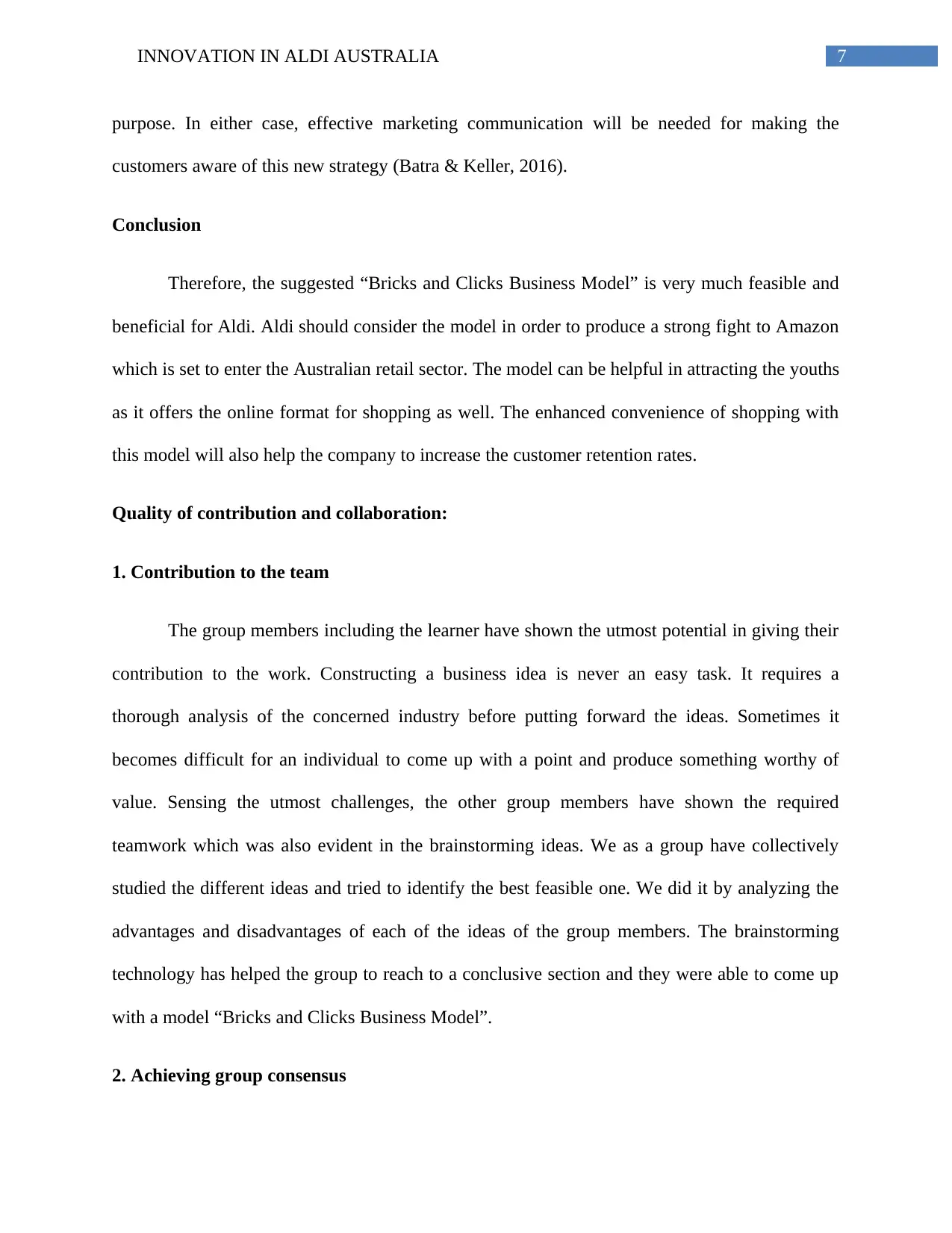
7INNOVATION IN ALDI AUSTRALIA
purpose. In either case, effective marketing communication will be needed for making the
customers aware of this new strategy (Batra & Keller, 2016).
Conclusion
Therefore, the suggested “Bricks and Clicks Business Model” is very much feasible and
beneficial for Aldi. Aldi should consider the model in order to produce a strong fight to Amazon
which is set to enter the Australian retail sector. The model can be helpful in attracting the youths
as it offers the online format for shopping as well. The enhanced convenience of shopping with
this model will also help the company to increase the customer retention rates.
Quality of contribution and collaboration:
1. Contribution to the team
The group members including the learner have shown the utmost potential in giving their
contribution to the work. Constructing a business idea is never an easy task. It requires a
thorough analysis of the concerned industry before putting forward the ideas. Sometimes it
becomes difficult for an individual to come up with a point and produce something worthy of
value. Sensing the utmost challenges, the other group members have shown the required
teamwork which was also evident in the brainstorming ideas. We as a group have collectively
studied the different ideas and tried to identify the best feasible one. We did it by analyzing the
advantages and disadvantages of each of the ideas of the group members. The brainstorming
technology has helped the group to reach to a conclusive section and they were able to come up
with a model “Bricks and Clicks Business Model”.
2. Achieving group consensus
purpose. In either case, effective marketing communication will be needed for making the
customers aware of this new strategy (Batra & Keller, 2016).
Conclusion
Therefore, the suggested “Bricks and Clicks Business Model” is very much feasible and
beneficial for Aldi. Aldi should consider the model in order to produce a strong fight to Amazon
which is set to enter the Australian retail sector. The model can be helpful in attracting the youths
as it offers the online format for shopping as well. The enhanced convenience of shopping with
this model will also help the company to increase the customer retention rates.
Quality of contribution and collaboration:
1. Contribution to the team
The group members including the learner have shown the utmost potential in giving their
contribution to the work. Constructing a business idea is never an easy task. It requires a
thorough analysis of the concerned industry before putting forward the ideas. Sometimes it
becomes difficult for an individual to come up with a point and produce something worthy of
value. Sensing the utmost challenges, the other group members have shown the required
teamwork which was also evident in the brainstorming ideas. We as a group have collectively
studied the different ideas and tried to identify the best feasible one. We did it by analyzing the
advantages and disadvantages of each of the ideas of the group members. The brainstorming
technology has helped the group to reach to a conclusive section and they were able to come up
with a model “Bricks and Clicks Business Model”.
2. Achieving group consensus
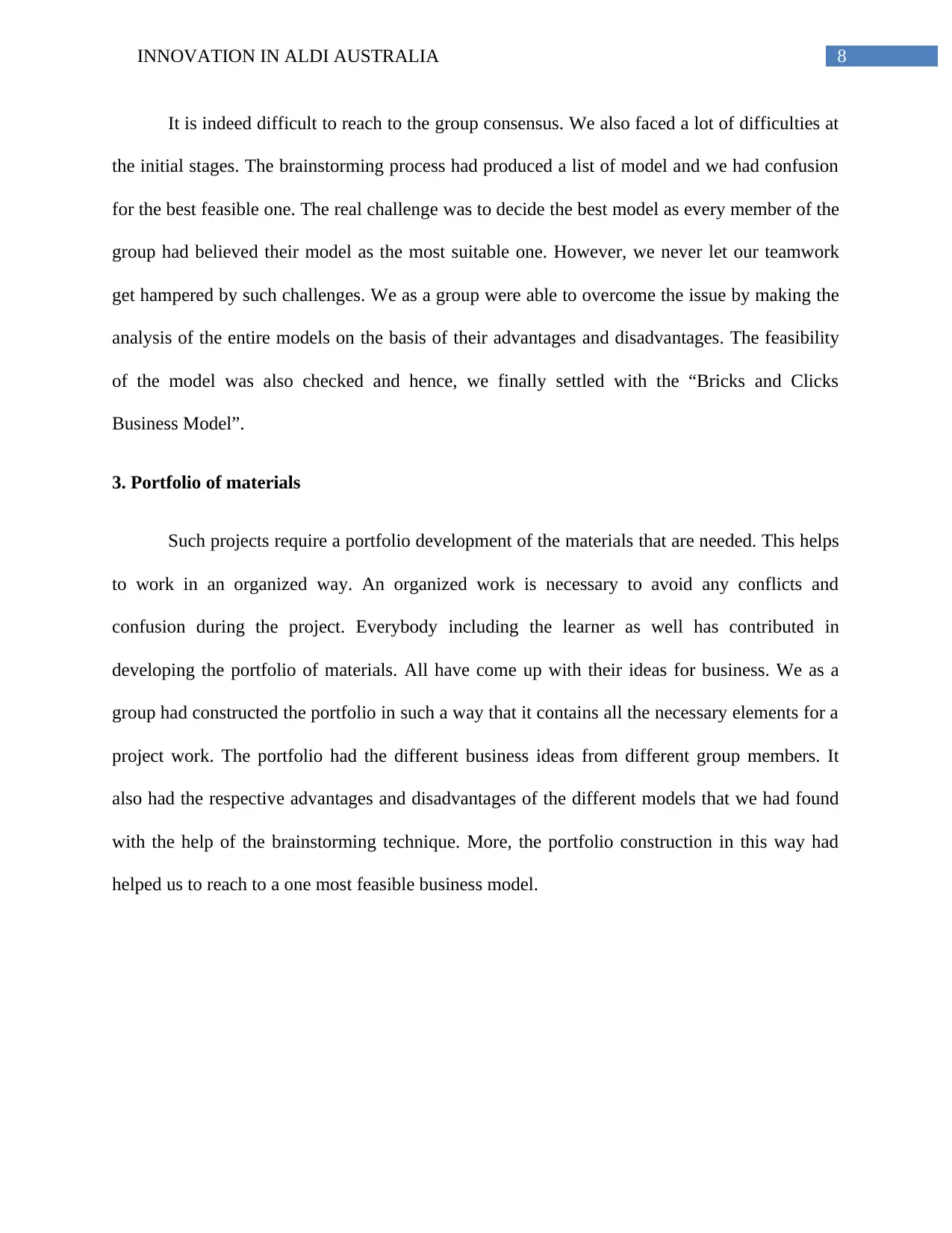
8INNOVATION IN ALDI AUSTRALIA
It is indeed difficult to reach to the group consensus. We also faced a lot of difficulties at
the initial stages. The brainstorming process had produced a list of model and we had confusion
for the best feasible one. The real challenge was to decide the best model as every member of the
group had believed their model as the most suitable one. However, we never let our teamwork
get hampered by such challenges. We as a group were able to overcome the issue by making the
analysis of the entire models on the basis of their advantages and disadvantages. The feasibility
of the model was also checked and hence, we finally settled with the “Bricks and Clicks
Business Model”.
3. Portfolio of materials
Such projects require a portfolio development of the materials that are needed. This helps
to work in an organized way. An organized work is necessary to avoid any conflicts and
confusion during the project. Everybody including the learner as well has contributed in
developing the portfolio of materials. All have come up with their ideas for business. We as a
group had constructed the portfolio in such a way that it contains all the necessary elements for a
project work. The portfolio had the different business ideas from different group members. It
also had the respective advantages and disadvantages of the different models that we had found
with the help of the brainstorming technique. More, the portfolio construction in this way had
helped us to reach to a one most feasible business model.
It is indeed difficult to reach to the group consensus. We also faced a lot of difficulties at
the initial stages. The brainstorming process had produced a list of model and we had confusion
for the best feasible one. The real challenge was to decide the best model as every member of the
group had believed their model as the most suitable one. However, we never let our teamwork
get hampered by such challenges. We as a group were able to overcome the issue by making the
analysis of the entire models on the basis of their advantages and disadvantages. The feasibility
of the model was also checked and hence, we finally settled with the “Bricks and Clicks
Business Model”.
3. Portfolio of materials
Such projects require a portfolio development of the materials that are needed. This helps
to work in an organized way. An organized work is necessary to avoid any conflicts and
confusion during the project. Everybody including the learner as well has contributed in
developing the portfolio of materials. All have come up with their ideas for business. We as a
group had constructed the portfolio in such a way that it contains all the necessary elements for a
project work. The portfolio had the different business ideas from different group members. It
also had the respective advantages and disadvantages of the different models that we had found
with the help of the brainstorming technique. More, the portfolio construction in this way had
helped us to reach to a one most feasible business model.
⊘ This is a preview!⊘
Do you want full access?
Subscribe today to unlock all pages.

Trusted by 1+ million students worldwide
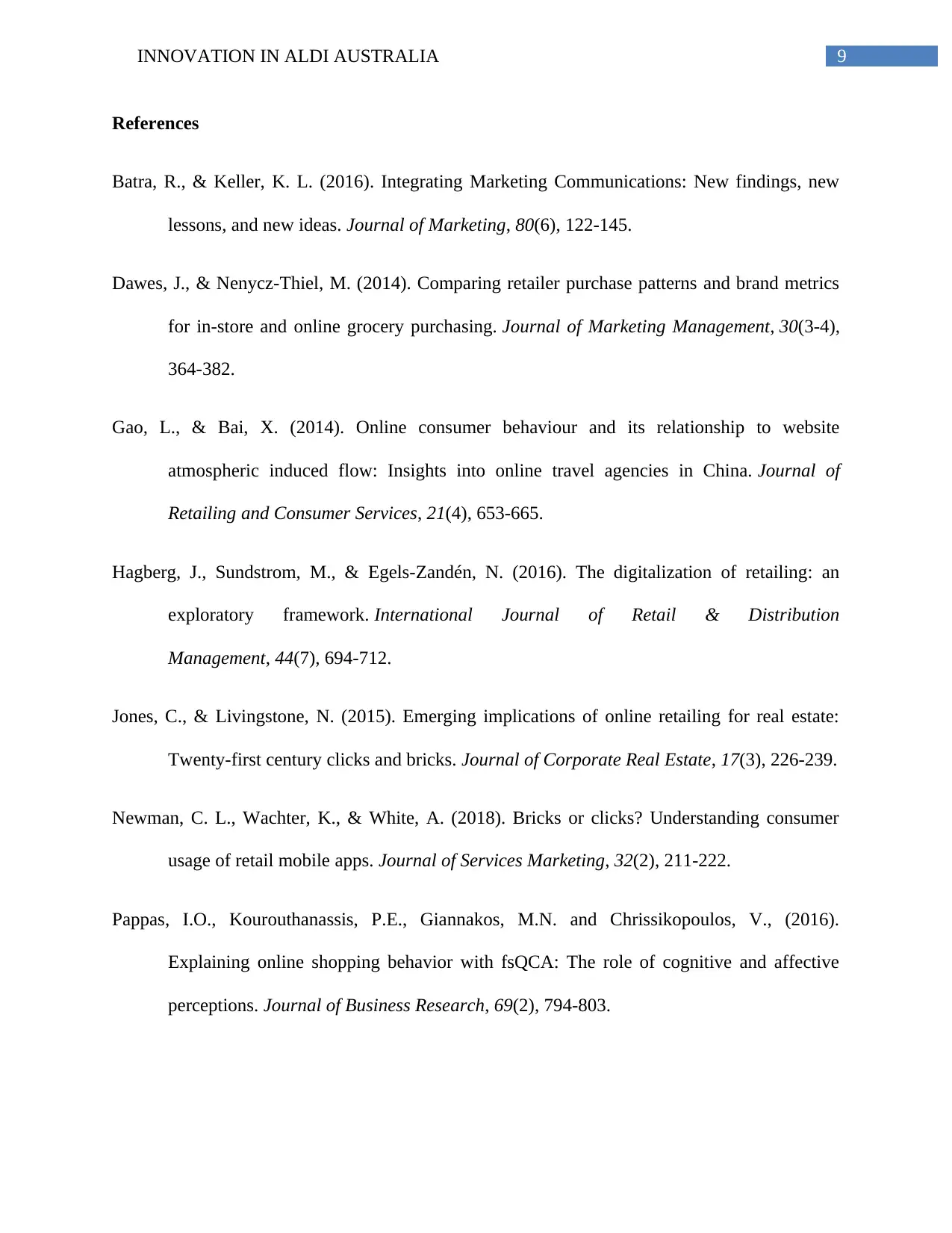
9INNOVATION IN ALDI AUSTRALIA
References
Batra, R., & Keller, K. L. (2016). Integrating Marketing Communications: New findings, new
lessons, and new ideas. Journal of Marketing, 80(6), 122-145.
Dawes, J., & Nenycz-Thiel, M. (2014). Comparing retailer purchase patterns and brand metrics
for in-store and online grocery purchasing. Journal of Marketing Management, 30(3-4),
364-382.
Gao, L., & Bai, X. (2014). Online consumer behaviour and its relationship to website
atmospheric induced flow: Insights into online travel agencies in China. Journal of
Retailing and Consumer Services, 21(4), 653-665.
Hagberg, J., Sundstrom, M., & Egels-Zandén, N. (2016). The digitalization of retailing: an
exploratory framework. International Journal of Retail & Distribution
Management, 44(7), 694-712.
Jones, C., & Livingstone, N. (2015). Emerging implications of online retailing for real estate:
Twenty-first century clicks and bricks. Journal of Corporate Real Estate, 17(3), 226-239.
Newman, C. L., Wachter, K., & White, A. (2018). Bricks or clicks? Understanding consumer
usage of retail mobile apps. Journal of Services Marketing, 32(2), 211-222.
Pappas, I.O., Kourouthanassis, P.E., Giannakos, M.N. and Chrissikopoulos, V., (2016).
Explaining online shopping behavior with fsQCA: The role of cognitive and affective
perceptions. Journal of Business Research, 69(2), 794-803.
References
Batra, R., & Keller, K. L. (2016). Integrating Marketing Communications: New findings, new
lessons, and new ideas. Journal of Marketing, 80(6), 122-145.
Dawes, J., & Nenycz-Thiel, M. (2014). Comparing retailer purchase patterns and brand metrics
for in-store and online grocery purchasing. Journal of Marketing Management, 30(3-4),
364-382.
Gao, L., & Bai, X. (2014). Online consumer behaviour and its relationship to website
atmospheric induced flow: Insights into online travel agencies in China. Journal of
Retailing and Consumer Services, 21(4), 653-665.
Hagberg, J., Sundstrom, M., & Egels-Zandén, N. (2016). The digitalization of retailing: an
exploratory framework. International Journal of Retail & Distribution
Management, 44(7), 694-712.
Jones, C., & Livingstone, N. (2015). Emerging implications of online retailing for real estate:
Twenty-first century clicks and bricks. Journal of Corporate Real Estate, 17(3), 226-239.
Newman, C. L., Wachter, K., & White, A. (2018). Bricks or clicks? Understanding consumer
usage of retail mobile apps. Journal of Services Marketing, 32(2), 211-222.
Pappas, I.O., Kourouthanassis, P.E., Giannakos, M.N. and Chrissikopoulos, V., (2016).
Explaining online shopping behavior with fsQCA: The role of cognitive and affective
perceptions. Journal of Business Research, 69(2), 794-803.
Paraphrase This Document
Need a fresh take? Get an instant paraphrase of this document with our AI Paraphraser
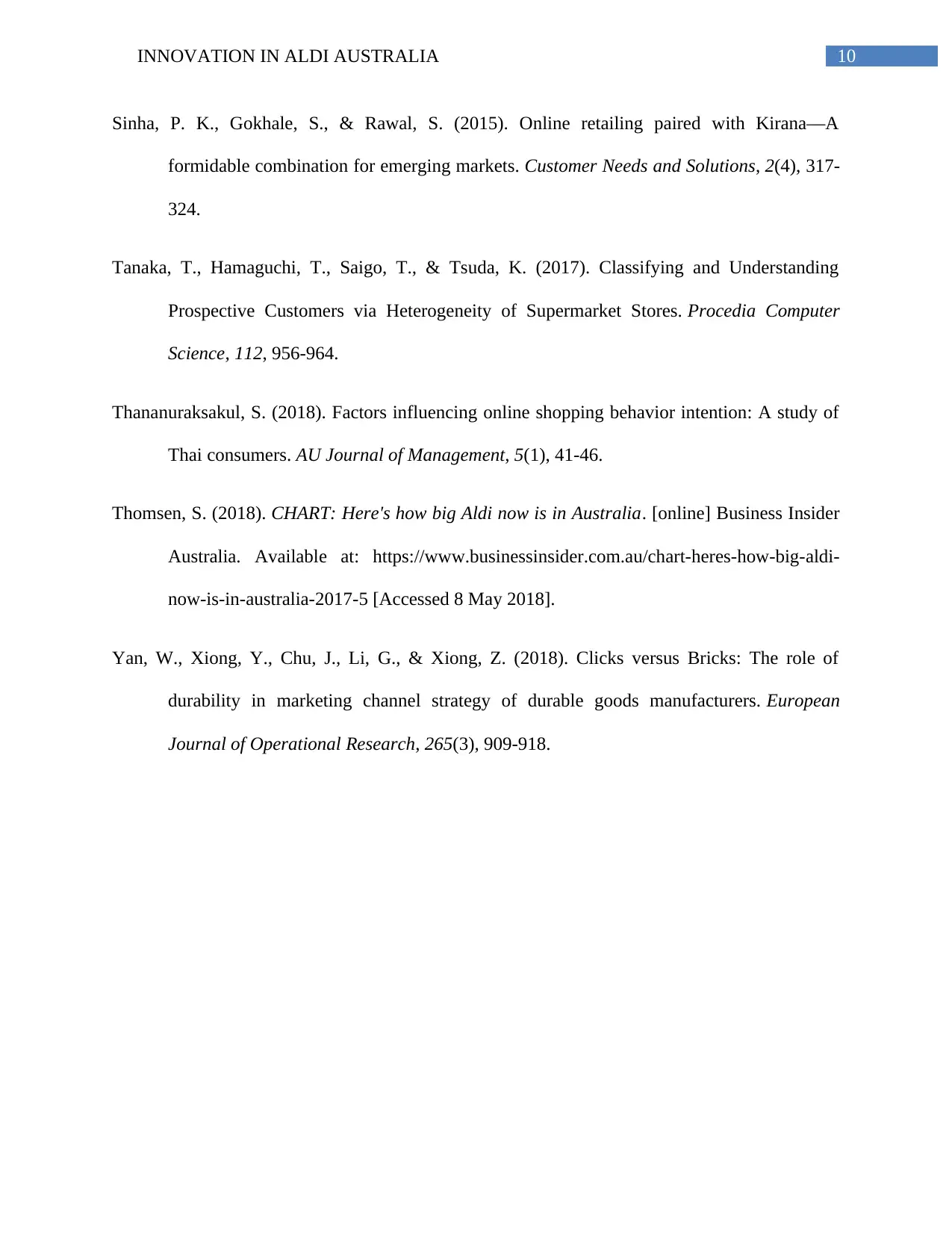
10INNOVATION IN ALDI AUSTRALIA
Sinha, P. K., Gokhale, S., & Rawal, S. (2015). Online retailing paired with Kirana—A
formidable combination for emerging markets. Customer Needs and Solutions, 2(4), 317-
324.
Tanaka, T., Hamaguchi, T., Saigo, T., & Tsuda, K. (2017). Classifying and Understanding
Prospective Customers via Heterogeneity of Supermarket Stores. Procedia Computer
Science, 112, 956-964.
Thananuraksakul, S. (2018). Factors influencing online shopping behavior intention: A study of
Thai consumers. AU Journal of Management, 5(1), 41-46.
Thomsen, S. (2018). CHART: Here's how big Aldi now is in Australia. [online] Business Insider
Australia. Available at: https://www.businessinsider.com.au/chart-heres-how-big-aldi-
now-is-in-australia-2017-5 [Accessed 8 May 2018].
Yan, W., Xiong, Y., Chu, J., Li, G., & Xiong, Z. (2018). Clicks versus Bricks: The role of
durability in marketing channel strategy of durable goods manufacturers. European
Journal of Operational Research, 265(3), 909-918.
Sinha, P. K., Gokhale, S., & Rawal, S. (2015). Online retailing paired with Kirana—A
formidable combination for emerging markets. Customer Needs and Solutions, 2(4), 317-
324.
Tanaka, T., Hamaguchi, T., Saigo, T., & Tsuda, K. (2017). Classifying and Understanding
Prospective Customers via Heterogeneity of Supermarket Stores. Procedia Computer
Science, 112, 956-964.
Thananuraksakul, S. (2018). Factors influencing online shopping behavior intention: A study of
Thai consumers. AU Journal of Management, 5(1), 41-46.
Thomsen, S. (2018). CHART: Here's how big Aldi now is in Australia. [online] Business Insider
Australia. Available at: https://www.businessinsider.com.au/chart-heres-how-big-aldi-
now-is-in-australia-2017-5 [Accessed 8 May 2018].
Yan, W., Xiong, Y., Chu, J., Li, G., & Xiong, Z. (2018). Clicks versus Bricks: The role of
durability in marketing channel strategy of durable goods manufacturers. European
Journal of Operational Research, 265(3), 909-918.
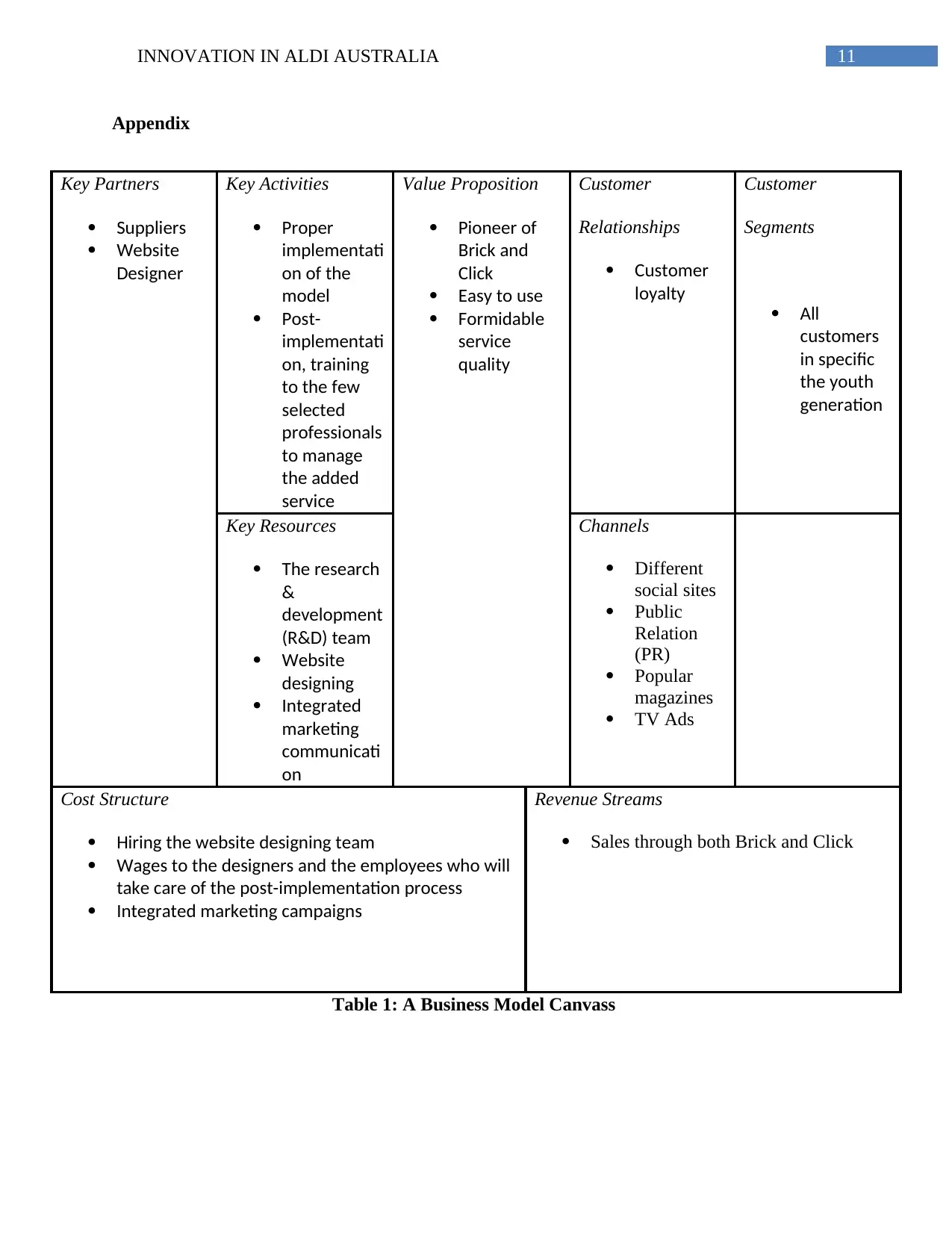
11INNOVATION IN ALDI AUSTRALIA
Appendix
Key Partners
Suppliers
Website
Designer
Key Activities
Proper
implementati
on of the
model
Post-
implementati
on, training
to the few
selected
professionals
to manage
the added
service
Value Proposition
Pioneer of
Brick and
Click
Easy to use
Formidable
service
quality
Customer
Relationships
Customer
loyalty
Customer
Segments
All
customers
in specific
the youth
generation
Key Resources
The research
&
development
(R&D) team
Website
designing
Integrated
marketing
communicati
on
Channels
Different
social sites
Public
Relation
(PR)
Popular
magazines
TV Ads
Cost Structure
Hiring the website designing team
Wages to the designers and the employees who will
take care of the post-implementation process
Integrated marketing campaigns
Revenue Streams
Sales through both Brick and Click
Table 1: A Business Model Canvass
Appendix
Key Partners
Suppliers
Website
Designer
Key Activities
Proper
implementati
on of the
model
Post-
implementati
on, training
to the few
selected
professionals
to manage
the added
service
Value Proposition
Pioneer of
Brick and
Click
Easy to use
Formidable
service
quality
Customer
Relationships
Customer
loyalty
Customer
Segments
All
customers
in specific
the youth
generation
Key Resources
The research
&
development
(R&D) team
Website
designing
Integrated
marketing
communicati
on
Channels
Different
social sites
Public
Relation
(PR)
Popular
magazines
TV Ads
Cost Structure
Hiring the website designing team
Wages to the designers and the employees who will
take care of the post-implementation process
Integrated marketing campaigns
Revenue Streams
Sales through both Brick and Click
Table 1: A Business Model Canvass
⊘ This is a preview!⊘
Do you want full access?
Subscribe today to unlock all pages.

Trusted by 1+ million students worldwide
1 out of 12
Related Documents
Your All-in-One AI-Powered Toolkit for Academic Success.
+13062052269
info@desklib.com
Available 24*7 on WhatsApp / Email
![[object Object]](/_next/static/media/star-bottom.7253800d.svg)
Unlock your academic potential
Copyright © 2020–2025 A2Z Services. All Rights Reserved. Developed and managed by ZUCOL.





